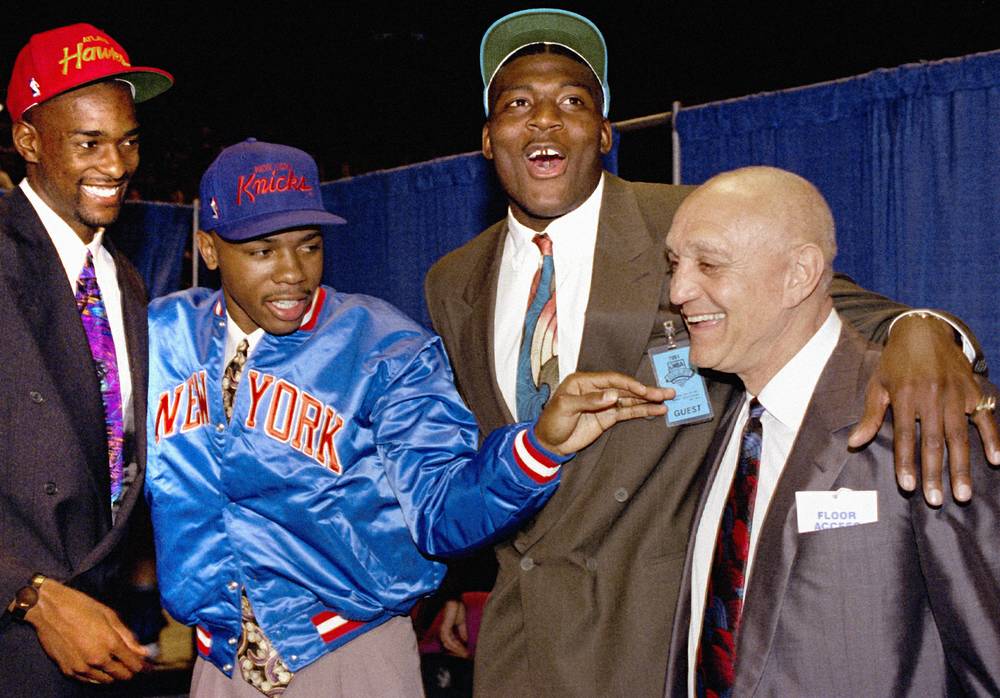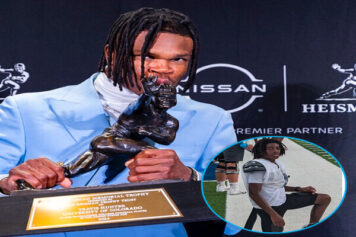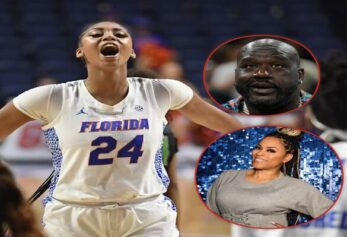This afternoon, I was saddened with the news that college basketball lost another coaching legend, UNLVs Jerry Tark the Shark Tarkanian.
Its no secret that Tarks health had been deteriorating in recent years, but I still wasnt prepared for todays news. In my opinion, the mans accomplishments and journey have never been fully appreciated, because he was every bit the coaching genius that his more celebrated contemporaries were.
Tarks UNLV Runnin Rebels of 1989-90 featuring Larry Johnson, Stacey Augmon, Greg Anthony, David Butler, Moses Scurry and Anderson Hunt is one of the greatest collections of players in the history of college basketball.
In terms of the embodiment of the full majesty, athletic wonder and urban artistic expression that makes basketball such an incredible spectacle, that UNLV team ranks right up there with the University of Houstons Phi Slamma Jamma, Louisville’s The Doctors of Dunk and the University of Michigans Fab Five.
And in terms of a teams singular greatness for one season, I think theyre right up there with John Woodens great UCLA teams with Kareem and Bill Walton, the 1996 Kentucky Wildcats, the 1982 North Carolina Tar Heels with Air Jordan, Sam Perkins and James Worthy, and any of the other great college teams you want to throw into the debate.
That Runnin Rebels crew demolished Duke, 103-73, in the 1990 NCAA championship with relentless pressure and fury to win by the widest margin ever in the final. Throughout the season, they cold-cocked opponents like Big George Foreman back in the days before he was known for his ubiquitous grill with a fearsome inside/outside offensive combo, that Velcro defense that was referred to as The Amoeba, and an aura and swagger that terrified opponents before the ball even tipped.
That team did not become great by accident. It was created by the hand and mind of a brilliant basketball architect.
Jerry Tarkanian grew up Cleveland, the son of Armenian immigrants. His parents escaped from Turkey in the midst of the horrific genocide, when 1.5 million Christian-Armenians were slaughtered by the Ottoman government from 1915-1922. His father, who worked in a Chrysler plant and ran a small neighborhood grocery store, died when Tark was just ten years old.
My upbringing was why I always related so well to kids from tough backgrounds or single family homes, Tarkanian wrote in his autobiography Runnin Rebel. I was always at home with city kids. I understood what it was like to be raised by one parent, to grow up poor, and have to move around and scrape to get things. Who was I to look down on anyone? I was like them. I was them.
As a youngster, the playground basketball courts in Cleveland provided him solace. When his mom moved to California, he made the varsity team at his high school in Pasadena.
All I did was play ball,wrote Tark.
He parlayed his passion for the game into a junior college scholarship, and eventually played Division I ball at Fresno State. Despite warming the bench, he still became a team captain due to his work ethic, fervor, zeal for the game and the respect that his teammates bestowed upon him.
While on a student-teaching assignment in the mid 1950s at Edison High School in Fresno, a predominantly African-American school, Tark was asked to be an assistant coach on the basketball team after the previous coach had a nervous breakdown. The head coaching position went to the football coach, who knew nothing about basketball. He pleaded with Tark to help, telling him that he would be the one running the show. Edison went on to win the city and county championship that year.
After a few years coaching preps, he made the jump to the junior college level. Because so few schools were recruiting African-Americans full throttle back then, some of the best talent in the country was mired in obscurity.
At Riverside City College, during a remarkable four-year stretch, Tarks teams won three California state championships with a record of 129-9, which included an undefeated 35-0 campaign. To recruit his first crop of players, he went back to his Midwest roots and searched for hungry, under-recruited talents in inner-city Cleveland and Detroit.
Along with the talented African-American players he brought out to California, Tark integrated a segregated community in the 1960s through the beautiful healing force of great basketball. His final team at Riverside, whom many consider the greatest junior college team ever, went 31-1 with a 43-point average margin of victory.
His next move was to Pasadena City College, where he turned a 5-23 program into a 35-1 juggernaut that captured his fourth consecutive California Junior College State Championship. He not only scouted high school players, but frequented recreation leagues, open gyms and outdoor playgrounds.
If there was a playground down by the beach, I went and watched, Tark wrote.
In 1968, he was named head coach at Long Beach State, which was making its Division I debut. That team went 23-3. In five years, filling his roster with tough, rugged and skilled talent from the Motor City, he won an astonishing 116 games, against only 17 losses.

(Tark at Long Beach State with his son Danny, Photo Credit: vegasseven.com)
Every day we went to St. Cecilias, a gym in Detroit where all the great players played, wrote Tark. I saw so many great players there that it was unbelievable. I was the only coach in there and the only white guy on a lot of nights. I got to know everyone in Detroit and for a while there, I had the city to myself. No one recruited in Detroit.
In 1971, Long Beach State barely lost to John Woodens UCLA dynasty, 57-55, in the Elite Eight of the NCAA Tournament.
And think about this: He might have won a national championship with Long Beach State had Los Angeles playground legend Raymond Lewis not bolted school early in the first semester to attend L.A. State (supposedly due to a Corvette provided to him), and had the Iceman, the inimitable George Gervin, one of the greatest players in the history of the NBA, not left Long Beach due to homesickness before ever playing a game for the 49ers.
But it was at UNLV where the Tark legend fully flowered. He brought in the single most important recruit in his career, Reggie Theus, and got the Runnin Rebels the countrys highest scoring team to the 1977 Final Four where they lost by one, 84-83, to the North Carolina Tar Heels.
He then went to Brooklyn to snag Sidney Green out of Thomas Jefferson High School.
Every day I stayed in Brooklyn, Sid went to the parks and we sat and watched the playground games, Tark wrote. All of the street guys came over and said hello. I had all sorts of credibility with the Brooklyn street guys.
In 1982-1983, the then-palatial Thomas and Mack Center, a state-of-the-art 19,000 seat arena, opened its doors as the Rebels, with Sid Green, Spoon James, Larry Anderson and Anthony Jones, won their first 23 games, attaining the countrys No. 1 ranking.
Unfortunately, they were without the services of the incredible Richie The Animal Adams that year due to personal issues. During his recruitment of Richie, Tark would run up the 22 flights of stairs in Adamss Bronx apartment building, yelling out Im Richie Adamss coach! the entire way so he wouldnt get snuffed by the shady characters in the stairwells and hallways.
In 1987, with The Hammer aka Armon Gilliam, Gerald Paddio, Jarvis Basnight, Freddie Banks, Gary Graham and Mark Wade, the Rebels went 37-1 before losing in the Final Four, 99-95, to Steve Alford, Keith Smart and the Indiana Hoosiers in one of the tournaments greatest games ever.
The Hammer dropped 32 points in that game, Banks scored 38 while connecting on 10 three-pointers and Mark Wade, one of the greatest passers and floor generals in college basketball history, dished out 19 assists.
Tarks biggest personal disappointment was the saga of NYC street legend Lloyd Swea Pea Daniels, whom Tark had on campus before a televised drug bust at a crack house ended the UNLV-Tark-Swea Pea era. But Tark later gave Lloyd a shot at a new life a few years down the road in the pros.
Theyll write the history of guards and start with Jerry West, Oscar Robertson, Magic Johnson and Lloyd Daniels, Tark once said before drug addiction and a hail of bullets robbed Lloyd of his transcendent talents.
As a testament to how phenomenal his talent was, Lloyd went on to become a solid role player in the NBA for a few years, despite the gunshot wounds and crack that had once ravaged his body.
Tark was dogged by investigations around alleged improprieties for years, but eventually cleared his name and won a multimillion dollar settlement from the NCAA in the end. While wrapping up his coaching career at Fresno State, he showed his playground roots some farewell love by coming to New York City to scoop up Rafer Alston, a playground legend known as Skip to My Lou.
From day one, Tarkanian was all about giving players with the odds stacked against them a shot at something bigger in life.
For me, its all about rungs on the ladder, Tark wrote in his autobiography. How many rungs on the ladder did you help a guy climb. Its about providing an opportunity that they wouldnt have otherwise gotten.
How much was Tark loved by his players? As NBA rookies, Greg Anthony, Larry Johnson and Stacey Augmon all wore his former number in honor and tribute.

(Photo Credit: lasvegasweekly.com)
I hope people take some time to truly appreciate what Jerry Tarkanian has given our beloved game of basketball on this day of his passing. Not only was he one of the greatest coaches of all-time, but he was also among the most unique.
He deserved, long ago, to be recognized and celebrated as one of the games greatest treasures.



